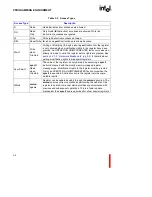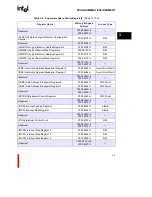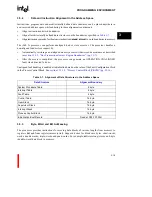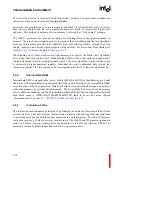
3-1
3
CHAPTER 3
PROGRAMMING ENVIRONMENT
This chapter describes the i960
®
Jx processor’s programming environment including global and
local registers, control registers, literals, processor-state registers and address space.
3.1
OVERVIEW
The i960 architecture defines a programming environment for program execution, data storage and data
manipulation.
Figure 3-1
shows the programming environment elements that include the following:
The processor includes several architecturally-defined data structures located in memory as part of
the programming environment. These data structures handle procedure calls, interrupts and faults
and provide configuration information at initialization. These data structures are:
3.2
REGISTERS AND LITERALS AS INSTRUCTION OPERANDS
With the exception of a few special instructions, the i960 Jx processor uses load and store instruc-
tions to access memory. All operations take place at the register level. The processor uses 16 global
registers, 16 local registers and 32 literals (constants 0-31) as instruction operands.
The global register numbers are g0 through g15; local register numbers are r0 through r15. Several
of these registers are used for dedicated functions. For example, register r0 is the previous frame
pointer, often referred to as pfp. The i960 processor compilers and assemblers recognize only the
instruction operands listed in
Table 3-1
. Throughout this manual, the registers’ descriptive names,
numbers, operands and acronyms are used interchangeably, as dictated by context.
•
4 Gbyte (2
32
byte) flat address space
•
register cache
•
instruction cache
•
set of literals
•
data cache
•
control registers
•
global and local general-purpose registers
•
set of processor state registers
•
interrupt stack
•
control table
•
system procedure table
•
local stack
•
fault table
•
process control block
•
supervisor stack
•
interrupt table
•
initialization boot record
Содержание i960 Jx
Страница 1: ...Release Date December 1997 Order Number 272483 002 i960 Jx Microprocessor Developer s Manual ...
Страница 24: ......
Страница 25: ...1 INTRODUCTION ...
Страница 26: ......
Страница 35: ...2 DATA TYPES AND MEMORY ADDRESSING MODES ...
Страница 36: ......
Страница 46: ......
Страница 47: ...3 PROGRAMMING ENVIRONMENT ...
Страница 48: ......
Страница 73: ...4 CACHE AND ON CHIP DATA RAM ...
Страница 74: ......
Страница 85: ...5 INSTRUCTION SET OVERVIEW ...
Страница 86: ......
Страница 111: ...6 INSTRUCTION SET REFERENCE ...
Страница 112: ......
Страница 195: ...INSTRUCTION SET REFERENCE 6 83 6 Opcode mov 5CCH REG movl 5DCH REG movt 5ECH REG movq 5FCH REG See Also LOAD STORE lda ...
Страница 233: ...7 PROCEDURE CALLS ...
Страница 234: ......
Страница 256: ......
Страница 257: ...8 FAULTS ...
Страница 258: ......
Страница 291: ...9 TRACING AND DEBUGGING ...
Страница 292: ......
Страница 309: ...10 TIMERS ...
Страница 310: ......
Страница 324: ......
Страница 325: ...11 INTERRUPTS ...
Страница 326: ......
Страница 369: ...12 INITIALIZATION AND SYSTEM REQUIREMENTS ...
Страница 370: ......
Страница 412: ......
Страница 413: ...13 MEMORY CONFIGURATION ...
Страница 414: ......
Страница 429: ...14 EXTERNAL BUS ...
Страница 430: ......
Страница 468: ......
Страница 469: ...15 TEST FEATURES ...
Страница 470: ......
Страница 493: ...A CONSIDERATIONS FOR WRITING PORTABLE CODE ...
Страница 494: ......
Страница 502: ......
Страница 503: ...B OPCODES AND EXECUTION TIMES ...
Страница 504: ......
Страница 515: ...C MACHINE LEVEL INSTRUCTION FORMATS ...
Страница 516: ......
Страница 523: ...D REGISTER AND DATA STRUCTURES ...
Страница 524: ......
Страница 550: ......
Страница 551: ...GLOSSARY ...
Страница 552: ......
Страница 561: ...INDEX ...
Страница 562: ......
Страница 578: ......
















































